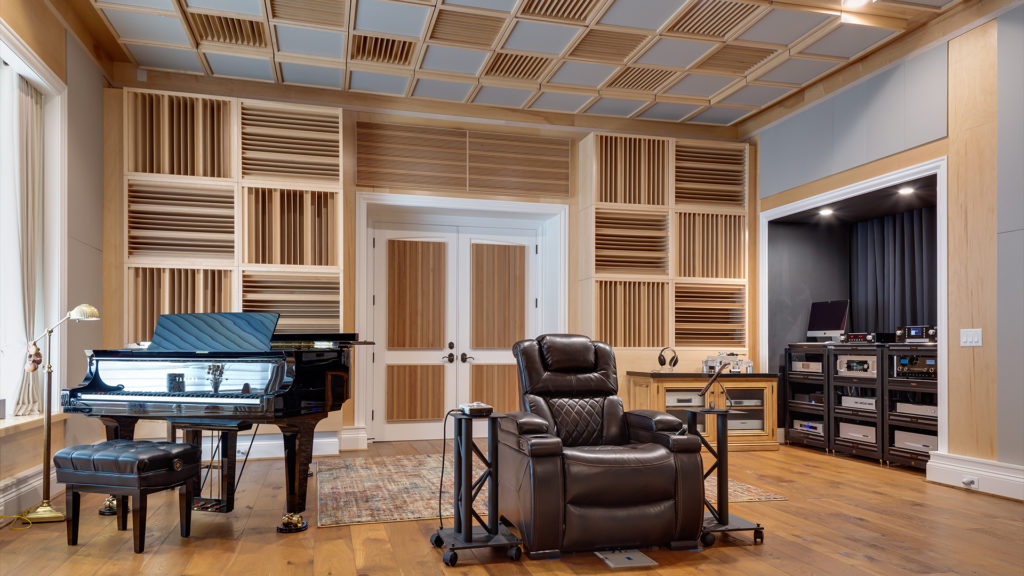Room acoustic design criteria falls into two main categories. The first is noise transmission. Any room acoustic design criteria must include the ability to keep noise from entering our studio and just as important keep noise from leaving the studio and bothering other people. Noise increases the distortion levels within our studios. If we raise the noise floor in our studios with more noise, then we must play our music or whatever usage we are using the room for at a higher level to rise above the existing noise floor. Creating more energy or noise to override existing noise levels produces a completely new set of issues that must be addressed including more treatment costs to manage the excess energy. Noise is managed correctly in any room acoustic design criteria by first measuring the noise we need to stop the transmission of. We must quantify and qualify the noise issues we face in order to assign the appropriate treatment for the frequency and amplitude of the noise. https://en.wikipedia.org/wiki/Noise#:~:text=Noise%20is%20unwanted%20sound%20considered,receives%20and%20perceives%20a%20sound
To measure noise, we can use your phone. We have apps that you can download and begin the noise measurement process. We must examine two variables with noise. We must measure what frequency the noise occurs at. This measurement tells us what type of noise energy we are dealing with. Is it low, middle, or high frequency noise. Each noise category requires a certain barrier technology to mitigate the transmission of that noise group. We must take our noise measurements over a seven day time period so we can determine the amplitude or strength of the noise. It is a combination of the frequency and amplitude or strength of the noise that we must use in any room acoustic design criteria.This noise mapping will give us a complete picture of what is going on throughout the entire week. This detail will determine which days are the noisest. These are the days that we need to focus our design upon. If we design for the maximum noise issues, we have the highest noise issues treated and then any noise issues throughout the week that are less than the maximums will be addressed within our barrier design.

Once we have our noise issues addressed and measured, we can then proceed to design the appropriate barrier. https://www.collinsdictionary.com/dictionary/english/sound-barrier. This process is referred to the shell of our room.The shell deals with noise transmission issues. The barrier or shell must be designed to deal with all the frequencies we measured during our seven day noise time study. Our barrier design will be directly based upon our noise measurements. Every material we use in our barrier design is dependent on the frequency and amplitude of the noise measurements we have taken. Every material type must be arranged or constructed in such a manner that addresses the measured frequency and amplitudes of our noise issues. There is no one size fits all. All noise issues are different and require different approaches. This is the reason why we must measure noise first and foremost. Any serious room acoustic design criteria must address noise first and foremost before any interior room treatment is specified.

After we have dealt with our noise issues, we can focus on the room size and associated volume. Our first variable to consider is room dimensions compared to usage requirements. A usage is what you are going to do within the room. Are you using the room for a recording studio application and playing instruments within the room? Are you mixing recorded sounds within the room? Are you listening to a two channel set up or using the room for home theater. We must first define the room usage, so we can choose the correct room size to avoid serious room distortion issues. Certain room usages such as a live room with drums and guitars will produce energy that won’t fit into the room size and volume. Energy that won’t fit will produce distortion. Our goal in choosing the proper room size and volume will be to minimize room distortion. Any serious room design criteria must include a discussion on matching the room size with the usage requirements. Once we have matched the room usage to the correct size and volume, we can then begin the absorption and diffusion treatment process.

Absorption and diffusion are our two types of sonic treatment options. Absorption reduces the strength or amplitude of the sound within our rooms. It does this by converting the airborne energy across its surface area creating friction. Friction produces heat and thus we have an energy transformation. This energy transformation produces absorption. We can absorb middle, and high frequency energy using molecular velocity or air movement across a treatment surface area. Low frequency energy requires a different form of technology to absorb its excessive energy requirements. Middle and high frequency energy can be absorbed using open celled acoustic foam. Diffusion is another technology that can assist us within our rooms. Diffusion reduces the impact of reflections and reduces this impact to a point where our ears and brain thinks the room sounds larger. The process is called localization. Any room acoustic design criteria must consider the proper surface area requirements for both absorption and diffusion technology.
Absorption Technologies: https://www.acousticfields.com/product/acda-10-activated-carbon-diaphragmatic-absorber/
Diffusion Technologies: https://www.acousticfields.com/product/sounddiffuser-acousticdiffuser-qd17/
About Us At Acoustic Fields: https://www.acousticfields.com/about/







